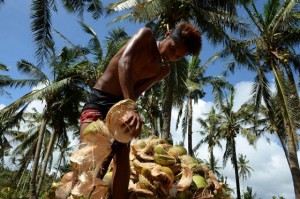Life is a constant throw of the dice for farmer Nilo Dilao and other residents of Samar, the ground zero for many of East Asia’s deadliest storms.
Homes, boats, crops, livestock and jobs are all on the line each time the monster winds roar in from the Pacific Ocean, leaving survivors to mourn their dead and pick up the broken pieces, year in and year out.
“Life is a struggle here,” Dilao, 43, told Agence France-Presse a few days after Typhoon Ruby (Hagupit) destroyed his shanty and killed more than 20 people this month.
He likened the plight of local people to those of stray chickens.
“We’re scratching at the soil non-stop in hopes of finding a scrap to eat,” he said.
Ruby came a year after Super Typhoon Yolanda (Haiyan), the strongest ever storm recorded on land, killed 7,350 people on Samar and neighboring islands.
Samar is often the first major Asian landmass hit by the more than 20 tropical storms or typhoons that are born in the Pacific Ocean each year.
With much of the mountainous island stripped by deforestation, most of its 1.8 million residents live on narrow, sea-level strips along the coast, at the mercy of the storms’ ferocious winds and tsunami-like ocean surges.
Living in the town of Taft on Samar’s east coast, the Dilao family survived the storm surges of Yolanda and Ruby by fleeing to a nearby hill, waiting them out under a raggedy tent made of bamboo frames and a tarpaulin sheet.
In nearby San Julian, small-scale farmer Benjie Baldenero was also struggling to cope with having lost his home after Yolanda when it happened again when Ruby battered the region.
The 40-year-old spoke of pledging the next harvest as collateral so he could borrow money to rebuild his grass hut again and replace flooded rice seedlings.
“We have not even repaid last year’s debts and here we are needing to take out more loans,” Baldenero told Agence France-Presse.
Typhoons and guerillas
The vicious cycle ensures Samar and the neighboring island of Leyte are among the poorest regions of the Philippines, accounting for just 2.2 percent of national economic output.
“Bad weather plays a major role in shaping our economy because typhoons destroy practically everything in their path,” Ben Evardone, a congressman and former governor of Eastern Samar province, told Agence France-Presse.
Six in 10 people on Samar’s east coast are poor, according to government data, fuelling a decades-old communist insurgency that has largely petered out across the rest of the Philippines.
Samar is one of only five regions of the country where New People’s Army rebels are still active, Philippine Army spokesman Colonel Noel Detoyato told Agence France-Presse.
“They continue to attract followers due to the poverty,” he said.
Typhoons and guerrillas also mean the island attracts few outside investors, Evardone
said.
There are few jobs available except farming and fishing, which are among those most vulnerable to the extreme weather.
Those in the few other industries also suffer during the storms.
Jaime Caballa, 53, saw his restaurant in the university town of Can-avid ripped apart by Ruby, then ransacked by looters.
With banks unwilling to lend without collateral and his modest savings gutted by Yolanda, the father-of-four now has to deal with loan sharks to finance repairs.
“The restaurant was shuttered for a week after Yolanda. This time, we’ll likely be out of business for months,” he told Agence France-Presse.
The extreme weather leaves the island with coconuts, also the Philippines’ principal export crop, as the main source of income.
Farmers also plant much less valuable sweet potatoes, cassava and taro to supplement their rice-based diet.
But even coconuts are no match for the strongest winds.
Yolanda destroyed most of the island’s coconut industry last year, felling more than 33 million trees across the central Philippines according to official estimates, while Ruby took care of much of what was left.
“It takes seven years for coconut trees to bear fruit. In the meantime, what will our people do? The impact of these typhoons will be felt over a long time,” Evardone said.
Exodus
Many Samar residents leave the island if they can.
Samar and Leyte are well-known sources of unskilled domestic workers and laborers for Manila as well as Cebu City.
Many educated residents also eventually move out, said Cristina Colico, 36, a lawyer and San Julian native who now works at the central bank in Manila.
“Samar residents can endure the storms, that’s not why they leave,” she told AFP.
“They just want to look for better jobs elsewhere.”
But this option is not always open to unskilled workers.
“I wish we could move elsewhere, but in reality we know we have nowhere else to go,” said Dilao the coconut farmer.
AFP


